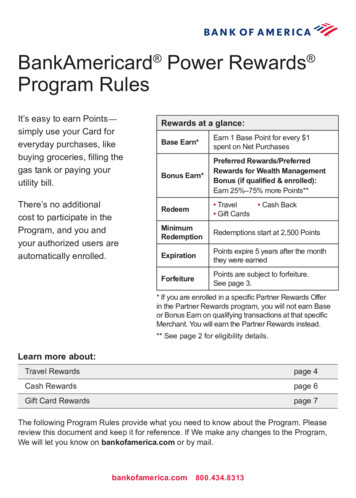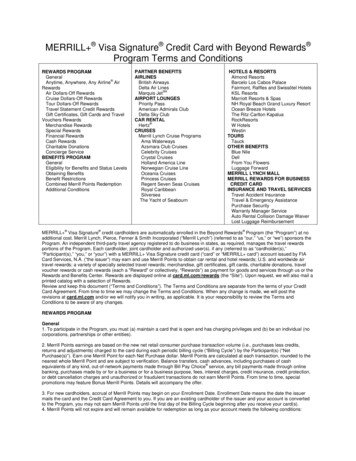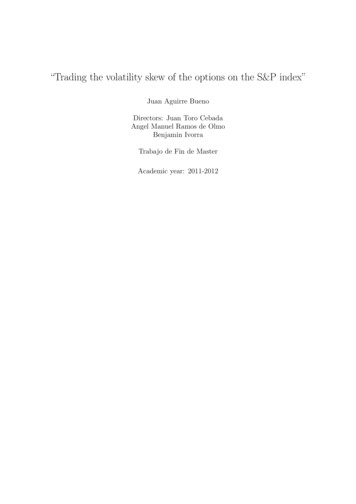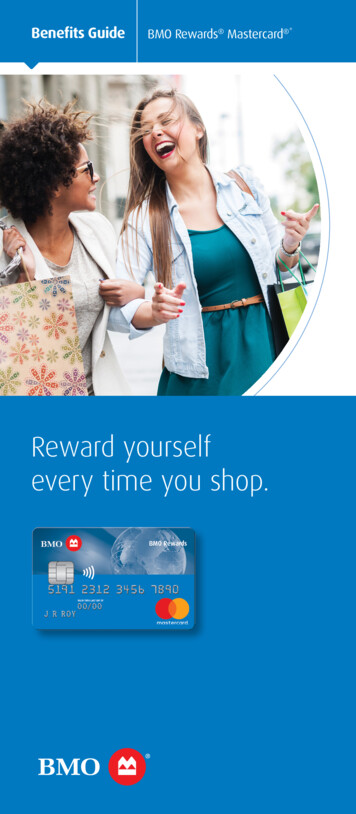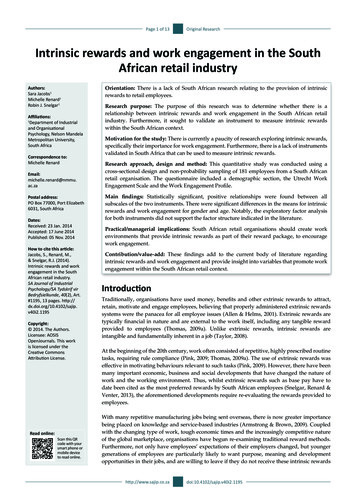
Transcription
Page 1 of 13Original ResearchIntrinsic rewards and work engagement in the SouthAfrican retail industryAuthors:Sara Jacobs1Michelle Renard1Robin J. Snelgar1Affiliations:1Department of Industrialand OrganisationalPsychology, Nelson MandelaMetropolitan University,South AfricaCorrespondence to:Michelle RenardEmail:michelle.renard@nmmu.ac.zaPostal address:PO Box 77000, Port Elizabeth6031, South AfricaDates:Received: 23 Jan. 2014Accepted: 17 June 2014Published: 05 Nov. 2014How to cite this article:Jacobs, S., Renard, M.,& Snelgar, R.J. (2014).Intrinsic rewards and workengagement in the SouthAfrican retail industry.SA Journal of IndustrialPsychology/SA Tydskrif virBedryfsielkunde, 40(2), Art.#1195, 13 pages. t: 2014. The Authors.Licensee: AOSISOpenJournals. This workis licensed under theCreative CommonsAttribution License.Read online:Scan this QRcode with yoursmart phone ormobile deviceto read online.Orientation: There is a lack of South African research relating to the provision of intrinsicrewards to retail employees.Research purpose: The purpose of this research was to determine whether there is arelationship between intrinsic rewards and work engagement in the South African retailindustry. Furthermore, it sought to validate an instrument to measure intrinsic rewardswithin the South African context.Motivation for the study: There is currently a paucity of research exploring intrinsic rewards,specifically their importance for work engagement. Furthermore, there is a lack of instrumentsvalidated in South Africa that can be used to measure intrinsic rewards.Research approach, design and method: This quantitative study was conducted using across-sectional design and non-probability sampling of 181 employees from a South Africanretail organisation. The questionnaire included a demographic section, the Utrecht WorkEngagement Scale and the Work Engagement Profile.Main findings: Statistically significant, positive relationships were found between allsubscales of the two instruments. There were significant differences in the means for intrinsicrewards and work engagement for gender and age. Notably, the exploratory factor analysisfor both instruments did not support the factor structure indicated in the literature.Practical/managerial implications: South African retail organisations should create workenvironments that provide intrinsic rewards as part of their reward package, to encouragework engagement.Contribution/value-add: These findings add to the current body of literature regardingintrinsic rewards and work engagement and provide insight into variables that promote workengagement within the South African retail context.IntroductionTraditionally, organisations have used money, benefits and other extrinsic rewards to attract,retain, motivate and engage employees, believing that properly administered extrinsic rewardssystems were the panacea for all employee issues (Allen & Helms, 2001). Extrinsic rewards aretypically financial in nature and are external to the work itself, including any tangible rewardprovided to employees (Thomas, 2009a). Unlike extrinsic rewards, intrinsic rewards areintangible and fundamentally inherent in a job (Taylor, 2008).At the beginning of the 20th century, work often consisted of repetitive, highly prescribed routinetasks, requiring rule compliance (Pink, 2009; Thomas, 2009a). The use of extrinsic rewards waseffective in motivating behaviours relevant to such tasks (Pink, 2009). However, there have beenmany important economic, business and social developments that have changed the nature ofwork and the working environment. Thus, whilst extrinsic rewards such as base pay have todate been cited as the most preferred rewards by South African employees (Snelgar, Renard &Venter, 2013), the aforementioned developments require re-evaluating the rewards provided toemployees.With many repetitive manufacturing jobs being sent overseas, there is now greater importancebeing placed on knowledge and service-based industries (Armstrong & Brown, 2009). Coupledwith the changing type of work, tough economic times and the increasingly competitive natureof the global marketplace, organisations have begun re-examining traditional reward methods.Furthermore, not only have employees’ expectations of their employers changed, but youngergenerations of employees are particularly likely to want purpose, meaning and developmentopportunities in their jobs, and are willing to leave if they do not receive these intrinsic i2.1195
Page 2 of 13(Tsui & Wu, 2005). Therefore, the use of and interest inintrinsic rewards is burgeoning, due to the positive workrelated impact of intrinsic rewards such as job satisfactionand emotional attachment (Nujjoo & Meyer, 2012).Organisations require employees to take initiative andresponsibility, adapt to customer needs, provide creativesolutions, share knowledge and work with other teamsin the organisation to be successful (Cruz, Perez &Cantero, 2009; Pink, 2009; Markova & Ford, 2011). Jobs inthe growing knowledge and service-based sectors oftenrequire high levels of employee innovation, knowledge andcreativity (Markova & Ford, 2011). These behaviours havebeen associated with work engagement (Towers Perrin,2005; Purcell, Kinnie, Hutchinson, Rayton & Swart, 2003;Thomas, 2009c).In the retail industry, employee behaviours such asproduct knowledge, delivering on promises and activelylistening to customers is what drives customer satisfaction(Evenson, 2007). For employees to behave in this manner,they must be mentally and emotionally engaged in theirwork and be willing to put in additional discretionary effort,all of which are features of work engagement (Gibbons,2006). It is therefore not surprising that there has beengrowing interest into how to drive work engagement,including within the retail industry.Moreover, with the flatter organisational structures thatare characteristic of many modern organisations, there isnow a greater need for employees to take initiative and beself-directing and flexible. With fewer middle managers,employees are to a certain extent required to self-manage theirtime and deliver independently on targets (Thomas, 2009c).This requires employees to be engaged in their work.This current context has led to the re-evaluation of the use ofpurely financial means to motivate and engage employees,with increasing evidence showing that extrinsic rewards, ontheir own, are insufficient tools to motivate and engage staff(Pink, 2009; Thomas, 2009a).Research purpose and objectivesThere is a scarcity of research investigating the importanceof intrinsic rewards in a South African context (Nujjoo &Meyer, 2012). There have been no previous scientific studiesfocusing on the relationship between intrinsic rewards andwork engagement within South Africa, as is evident from theliterature review to follow. Coupled with this, to the authors’knowledge, there is no commercially available instrument tomeasure intrinsic rewards that has been validated in SouthAfrica.Work engagement is particularly important in the retailindustry, in which an employee’s level of work engagementhas been found to be positively related to levels of customersatisfaction (Kenexa, 2012). It is important for organisationsto understand what job characteristics are linked with workhttp://www.sajip.co.zaOriginal Researchengagement to be able to increase the level of engagement oftheir employees.Given the employee performance, attitudes and behavioursthat organisations desire, ensuring that employees areengaged at work has become increasingly important, asmounting research links engaged employees to a multitudeof positive employee and organisational benefits such asbetter psychological health, motivation and enthusiasm(Bakker & Demerouti, 2009; Bakker, Schaufeli, Leiter &Taris, 2008; Field & Buitendach, 2011). There is thereforegreat impetus to better understand factors related to workengagement.Based on the above, the primary purpose of this study is toaddress the gap in empirical research by investigating therelationship between intrinsic rewards and work engagementin the South African retail context. Additional aims includeto investigate the impact of demographic variables suchas age and gender on levels of intrinsic rewards and workengagement, as well as to determine with a level of statisticalsignificance that the two measuring instruments employed inthis study (namely, the Work Engagement Profile to measureintrinsic rewards and the Utrecht Work Engagement Scale tomeasure work engagement) are valid and reliable within theSouth African context.In order to answer the research question, “What isthe relationship between intrinsic rewards and workengagement in the South African retail industry?” – thisarticle will provide a brief literature review outliningintrinsic rewards and work engagement, followed by theresearch design for this study. Thereafter, a discussion ofthe results will be provided, which will address the study’spurpose and objectives.Literature reviewIntrinsic rewardsIntrinsic rewards are psychological rewards or positiveand emotionally rewarding work-related experiences thatindividuals gain from their work and work environment(Thomas, 2009a). Unlike extrinsic rewards, they areintangible, yet are fundamentally inherent in a job(Taylor, 2008). Since rewards motivate and reinforcebehaviour, for the purpose of this study, any intrinsic factorthat motivates within the work context has been interpretedas an intrinsic reward.Intrinsic rewards have been conceptualised in slightlydifferent ways by researchers. Pink (2009) specifies threekey intrinsic rewards that drive motivation at work, namelyautonomy, mastery and purpose. Houkes (2002) found acausal effect between task significance, autonomy, feedback,task variety and intrinsic work motivation. Therefore, workthat provides an experience that is interesting, challenging,meaningful, enjoyable, fulfilling and has variety andadvancement opportunities, as well as an environment thatprovides constructive feedback, is intrinsically rewarding.doi:10.4102/sajip.v40i2.1195
Page 3 of 13This is because it enables employees to feel competent,responsible and autonomous, which increases intrinsic workmotivation for employees (Amabile, Hill, Hennessey &Tighe, 1994; Bitzer, Schrettl & Scroder, 2007; Herzberg, 1966;Shamir, 1991; Marchington & Wilkinson, 2008; Thomas,2009a). Confirmed by Hackman and Lawler’s (1971) JobCharacteristics Theory, work and a working environmentthat can produce these emotional outcomes described abovepromote personal satisfaction and individual growth.For the purposes of this study, Thomas’s (2009a) intrinsicrewards will be focused on. Thomas specifies four typesof intrinsic rewards gained from work, which providepositive emotional energy and result in motivation andpositive feelings. These intrinsic rewards are a sense ofmeaningfulness, choice, competence and progress.Meaningfulness involves the feeling that one’s job isworthwhile and has a purpose that is part of a bigger picture(Thomas, 2009b). It includes employees knowing whythey do what they do and knowing that their daily taskscontribute in some way to a larger whole, that is, that theyare significant to the success of the organisation (Pink, 2009).Working towards a worthwhile purpose is rewarding andsatisfying for employees and can sustain motivation over thelong-term (Thomas, 2009c).Choice is similar to the intrinsic reward of ‘autonomy’described by other authors (Amabile et al., 1994; Pink,2009). It includes the ability to choose one’s own activitiesand methods of performing these activities and empowersemployees to be self-directing, independent and responsiblefor their work outcomes (Thomas, 2009c). Allowingemployees to be autonomous to select their own methodsfor accomplishing a task enables them to feel personallyresponsible for the quality of their activities and subsequentoutcomes, such as the service received by the customer(Thomas, 2009c).Competence at work involves employees feeling capableof handling their work tasks and performing in a way thatmeets or exceeds their personal standards of achievement(Deci & Ryan, 1985; Thomas, 2009a). It can be seen as similarto the concept of ‘mastery’ as defined by Pink (2009), whichemphasises employees continuously learning and putting ineffort in order to improve at something that matters.Finally, a sense of progress involves feeling that one’s workis moving in the desired direction and accomplishing thedesired or required outcomes (Thomas, 2009a). Particularlyif the goal is meaningful, progress provides enthusiasmand positive feelings, creating motivation to continue(Thomas, 2009c).Intrinsic rewards have been linked to many importantoutcomes for organisations. For example, Thomas (2009a)has found the abovementioned four intrinsic rewards tobe strongly correlated to job satisfaction and professionaldevelopment (Sutz, 1991, cited in Thomas, 2009b; Thomashttp://www.sajip.co.zaOriginal Research& Tymon, 1994). Intrinsic rewards have been shown to bepositively correlated with creativity (and extrinsic rewardsnegatively correlated with creativity) (Amabile et al., 1994).Employees who experience high levels of intrinsic rewardsreport higher levels of job satisfaction, lower stress, strongfeelings of well-being and intrinsic motivation, as well asincreased professional development (Ryan & Deci, 2000;Sutz, 1991, in Thomas, 2009b; Thomas & Tymon, 1994).Furthermore, in the South African context intrinsic rewardshave been linked to affective commitment and intrinsicmotivation (Nujjoo & Meyer, 2012). Pink (2009) explains thatintrinsic rewards can create sustainable motivation over thelong-term, because the need for competence or mastery oftasks is a long-term process. Furthermore, Pink argues thatthe use of intrinsic rewards reduces the requirement forsupervision and middle management, because employeesare intrinsically motivated and therefore self-directing.Work engagementWork engagement is part of the positive psychologymovement, focusing on optimal functioning, well-being,enthusiasm and health at work (Schaufeli & Bakker, 2003).Gibbons (2006) defines work engagement as the increasedemotional and intellectual connection that employeeshave for their job, organisation or co-workers, whichleads to increased discretionary effort in their work. Thekey attitudinal and behavioural components for workengagement definitions include commitment, enthusiasmtowards work, dedication, loyalty, directed effort,involvement in one’s job and satisfaction (Gallup, 2012;Macey & Schneider, 2008; Towers Perrin, 2005).Kahn (1990) states that employees are engaged with theirwork when they identify with their roles, and expressthemselves through their roles physically, emotionally andcognitively. Work engagement has also been defined as theantithesis of burnout (Maslach & Leiter, 1997). However,Schaufeli, Salanova, Gonza lez-Roma and Bakker (2002)argue that burnout and work engagement are distinct andshould be assessed separately and independently of oneanother.For the purpose of this research, work engagement willbe defined based on Schaufeli et al.’s (2002) conception ofwork engagement: a positive work-related state of mind,defined by three dimensions, namely vigour, dedication andabsorption. Vigour includes mental resilience, persistencewhen confronted with difficulties at work, pervasive positivefeelings, energy and enthusiasm towards work (Bakker et al.,2008; Schaufeli & Bakker, 2003). Dedication is characterisedby enthusiasm, pride, persistence and being activelyinvolved in one’s work, including feeling challenged byone’s job (Bakker et al., 2008). Absorption is when individualsare concentrating so fully and are so engrossed in their workthat time passes without being noticed (Bakker et al., 2008).Research on work engagement has found a positiverelationship with the ability to cope in stressful situations,doi:10.4102/sajip.v40i2.1195
Page 4 of 13higher job enthusiasm, job satisfaction, happiness atwork and organisational commitment (Bakker et al., 2008;Bakker & Demerouti, 2009; Field & Buitendach, 2011).At an organisational level, work engagement has beenstrongly correlated with positive outcomes such as lowerabsenteeism, higher retention, fewer safety incidents,increased productivity, higher company profits andincreased customer loyalty and satisfaction (Bakker &Demerouti, 2009; Gallup, 2012; Harter, Schmidt & Hayes,2002; Harter, Schmidt, Killham & Asplund, 2006; Schaufeli& Bakker, 2003).Relationship between intrinsic rewards and workengagementOrganisations have realised that ‘throwing money’ atemployees may have little effect on work engagement, andthus have now begun focusing on ways to enable intrinsicrewards (Towers Perrin, 2005). For this reason, there are arange of studies that have related intrinsic rewards andsources of intrinsic rewards to work engagement. Forexample, sources of intrinsic rewards such as job challenge,inclusion in decision-making and development opportunitieshave been found to be positively related to workengagement (Gibbons, 2006; Purcell et al., 2003). Accordingto the job-demand resources model, job autonomy, taskvariety, positive performance feedback and social supportgained from work are strongly positively related to workengagement (Bakker & Demerouti, 2007). Rothmann andRothmann (2010) validated this model in the South Africancontext. Most of these studies are cross-sectional in designand therefore causation cannot be established.Shernoff, Csikszentmihalyi, Schneider and Shernoff (2003)found that when students experienced tasks to be sufficientlychallenging and had the appropriate skills to competentlyachieve the tasks, they had higher levels of engagement. Thishighlights that competence is related to higher levels of workengagement. Organisational cultures that restrict autonomyand empowerment have been found to be related to lowerjob satisfaction and work engagement (Nantha, 2013).Kahn (1990) argues that if a task is meaningful to employees,then they will be more motivated to be engaged in theirwork. Empirical research supports this argument, findingthat meaningfulness of work is a strong predictor ofwork engagement in the South African context (Olivier &Rothmann, 2007; Rothmann & Rothmann, 2010).Research designResearch approachThis research falls within the paradigm of positivepsychology (see Seligman & Csikszentmihalyi, 2000),focusing on positive organisational attitudes in the SouthAfrican work context. The study used a quantitative researchmethod, having utilised questionnaires to collect data. Apilot study was initially conducted as part of the empiricalresearch, followed by a final study based on the pilot studyresults. A cross-sectional design, which involves drawing ahttp://www.sajip.co.zaOriginal Researchsample from the target population at a single point in time(Babbie, 2013), was utilised for both the pilot study and finalstudy.The purpose of the pilot study (n 33) was to determinewhether the two instruments, the Work Engagement Profile(WEP) and the Utrecht Work Engagement Scale (UWES),maintained reliability within the South African context. Thiswas necessary because the WEP has not previously beenutilised in South Africa. Based on Cronbach’s alpha analysis,each subscale and the overall scales of the WEP and UWEShad sufficient internal reliability and sufficient inter-itemreliability levels. The Cronbach’s alphas for the pilot studywere 0.95 and 0.90 respectively. Therefore, both instrumentswere determined to be reliable for use in the final study,with no need to remove or edit any items. These tables wereexcluded from this article due to space constraints. Themethod and results presented thus relate only to the finalstudy.Research methodResearch participantsThe target population for this study was employees workingwithin the South African retail industry. The sample wasdrawn from a single South African retail organisation,headquartered in Port Elizabeth, South Africa. Nonprobability sampling in the form of purposive sampling wasused to collect data. Purposive sampling involves selecting asample based on the target population and the nature of theresearch aims (Babbie, 2013).Whilst 323 questionnaires were distributed to employees, atotal of 208 completed questionnaires were returned. Thisreflects a response rate of 64.4%. Of these 208 returnedquestionnaires, 13 were incomplete and were thereforeexcluded. In addition, Malhotra (2010) explains that data thatis logically inconsistent may be regarded as unsatisfactoryand therefore should be excluded. Item response bias,where respondents give inaccurate information, may alsobias the results and should be excluded (Malhotra, 2010). Intotal, 14 respondents ticked only one answer (for example,strongly agree) for every item in their questionnaires. Forthe reasons mentioned above, these were regarded as biasedand inconsistent and were thus excluded. The total numberof questionnaires used for analysis was therefore 181. Thisrepresents responses from 56% of the sample.Characteristics of the sample: Table 1 displays thebiographical characteristics of the respondents. This samplewas comprised of 37 (20.4%) men and 144 (79.6%) women.The largest proportion of the sample was aged 28 to 37 years(40.3%), followed by 18 to 27 years (30.9%). Table 1 alsoshows that 37.0% of the respondents were mixed race, 36.5%were black and 25.4% were white. In terms of occupationalgroups, the factory and warehouse group made up thelargest proportion of the sample (52.5%), followed byemployees working directly with customers (32.0%) andhead office employees (15.5%).doi:10.4102/sajip.v40i2.1195
Page 5 of 13Measuring instrumentsThe composite questionnaire used for this study was a fixedanswer questionnaire, requiring the respondents to selectfrom a series of pre-determined answers (Malhotra, 2010). Itconsisted of a biographical data section and two measuringinstruments, namely the WEP and UWES.The Work Engagement Profile (WEP): The WEP is a global,commercially available instrument used to measure intrinsicrewards in organisations. It is owned by the Americancompany CPP (Thomas, 2009b). Whilst this instrumentis usually purchased for use, CPP granted permission tothe authors to use this instrument for academic researchpurposes.This 24-item self-report questionnaire is comprised of foursubscales, which measure the extent to which the fourtypes of intrinsic rewards explained in the literature review(namely meaningfulness, competence, choice and progress) areexperienced within a respondent’s work. Each subscalecontains six items, measured using a seven-point Likertscale. Respondents are required to choose their level ofagreement or disagreement for each item from the predetermined categories, ranging from 0 (strongly disagree) to6 (strongly agree). The WEP was selected because it is one ofthe only available previously validated instruments foundby the authors to measure levels of intrinsic rewards in anorganisational setting.For this study, certain words on several items were changedor substituted in the WEP by the authors, to ensure thatthe items would be interpretable within the South Africancontext. Permission was granted from CPP to make thesechanges, and a legal contract was drawn up between theauthors and CPP in this regard.The Utrecht Work Engagement Scale (UWES): The UWESwas used to measure work engagement in the sample. TheUWES was originally developed as a 24-item questionnaireto measure these dimensions, mostly consisting of positivelyTABLE 1: Characteristics of respondents (n 8 .0Other10.6Mainly directly with customer5832.0Working only occasionally customers, mainlyhead office2815.5Factory or warehouse9552.5AgeRacial groupOccupationalgroupf, frequency.http://www.sajip.co.zaOriginal Researchrephrased items from Maslach’s Burnout Inventory(Maslach, Jackson & Leiter, 1996). This instrument wasvalidated on two different samples, during which 17 itemswere determined to be sound (Schaufeli et al., 2002). TheUWES uses a seven-point Likert-scale, on which respondentsselect how often they have each feeling at work, rangingfrom 0 (Never) to 6 (Always).The UWES is composed of three subscales, namely vigour(six items), dedication (five items) and absorption (six items).These measure the three dimensions of work engagementexplained in the literature review.Strong internal consistency has been found for the UWESboth internationally and in the South African context(see for example, Coetzee & De Villiers, 2010; Rothmann& Rothmann, 2010; Schaufeli & Bakker, 2003; Storm &Rothmann, 2003). Storm and Rothmann (2003) found that theUWES can be used to measure work engagement in SouthAfrica, as there is no uniform or non-uniform bias betweenracial groups.Research procedure and ethical considerationsA paper-and-pen method was used for this study. Theintroduction to the questionnaire stated the purpose of theresearch, instructions for completing the questionnaire andassurances of confidentiality and anonymity. The collectionprocedure varied slightly depending on whether therespondent was at head office, factory and warehouse or theretail stores.Head office, factory and warehouse employees: Theauthors handed out questionnaires to every member of staffand left a sealed questionnaire collection box at reception forcompleted questionnaires to be dropped into.Retail employees: The organisation’s regional retailmanagers assisted with the data collection by handing outquestionnaires to all employees at every store. A sealedquestionnaire collection box was left in each store, intowhich completed questionnaires could be deposited. Allboxes from around SA were then delivered directly to theauthors upon completion of the data collection phase.Ethical considerations: To ensure that the research wasconducted in an ethical manner, permission to conduct thestudy was obtained from the owners and directors of theretail organisation prior to the beginning of the study. Anemail was then sent out to all employees of the organisationby the head of human resources, outlining the purposeand procedure of the research and requesting supportfrom the organisation’s employees. Managers with accessto computers were asked to pass this information on to allemployees without computer access. Whilst all employeeswere requested to take part in the study, participationwas purely voluntary and no employees were forced orcoerced to take part. Consent was assumed by the act ofdoi:10.4102/sajip.v40i2.1195
Page 6 of 13filling in the questionnaire and returning it. Confidentialityand anonymity was ensured for all participants and noemployee names or individual identifiers appeared on thequestionnaires. All completed questionnaires were droppedinto the sealed communal collection boxes mentioned above,in order to maximise the perception of anonymity for theparticipants. Finally, no information about individualrespondents was given to the organisation once the data hadbeen analysed.Statistical analysisTo complete the statistical analysis, two programs wereutilised, namely Microsoft Excel and Statistica (version11), a statistics and analysis software package. Descriptivestatistics were utilised to describe the data, includingthe mean, minimum, maximum and standard deviation.Cronbach’s alpha coefficients were calculated for eachsubscale in the WEP and UWES to determine the internalconsistency between each item and evaluate the reliabilityof each instrument.Confirmatory factor analysis was performed to determinethe underlying factor structure of the WEP and UWES forthe South African sample in this study. Pearson productmoment correlations were utilised to ascertain the strengthof the relationships between each factor within the WEPand UWES (Malhotra, 2010). A coefficient of 0.30 or abovewas used as a cut-off to represent practically significantcorrelations (Hair, Black, Babin & Anderson, 2010).Analysis of variance (ANOVA) was used to determinewhether there were statistically significant differencesacross demographic variables with more than two levels(age, race and occupational group). T-tests were usedto determine statistical differences between genders.Furthermore, post-hoc Tukey tests were performed todetermine whether there were statistically significantdifferences for the WEP and UWES factors betweendemographic variables. Cohen’s d statistic, which reflectsthe effect size, was used to determine the practicalsignificance of these results (Stommel & Willis, 2004). Theguidelines used for interpretation indicate that a smalleffect size occurs when d is between 0.20 and 0.50. Amoderate effect size occurs when d is between 0.50 and 0.80and a large effect size occurs when d is equal to or greaterthan 0.80 (Gravetter & Wallnau, 2009).Original ResearchResultsDescriptive statistics and Cronbach’s alphacoefficientsTable 2 summarises the key descriptive statistics for the WEPand UWES by displaying the minimum, maximum, mean,standard deviation and Cronbach’s alphas for the variablesunder study. It is evident that both measuring instrumentshave acceptable internal reliability as they are above 0.60(Malhotra, 2010), with the reliability coefficient for the totalWEP being 0.93 and for the total UWES being 0.82. Theauthors note though that the Cronbach’s alpha values forthe WEP subscales in this study are slightly lower than thosefound by Burke (2004), Tymon (1994, in Thomas, 2009b), andForest (2008, in Thomas 2009b). The same can be said for theUWES Cronbach’s alpha values presented in Schaufeli andBakker (2003), Storm and Rothmann (2003), and Coetzee andDe Villiers (2010), as compared to this study.Confirmatory factor analysisConfirmatory f
rewards to retail employees. Research purpose: The purpose of this research was to determine whether there is a relationship between intrinsic rewards and work engagement in the South African retail industry. Furthermore, it sought to validate an instrument to measure intrinsic rewards within the South African context.


